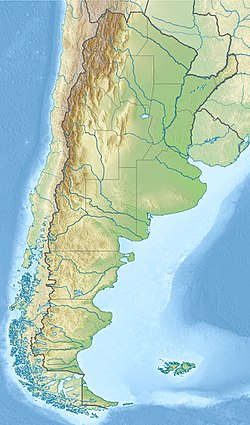Top Qs
Timeline
Chat
Perspective
Los Rastros Formation
Geological formation in Argentina From Wikipedia, the free encyclopedia
Remove ads
The Los Rastros Formation is a mid-Carnian fossiliferous formation of the Agua de la Peña Group, in the Ischigualasto-Villa Unión Basin of northwestern Argentina. Fossil archosaur tracks,[1] as well as many insects,[2] fish,[3] bivalves, crustaceans and plants have been reported from the formation.[4]
Remove ads
Geology
The formation overlies the Chañares Formation (and/or the Ischicuca Formation), and is overlain by the Ischigualasto Formation.[5] The formation belongs to the Agua de la Peña Group of the Ischigualasto-Villa Unión Basin, where it is exposed in the Ischigualasto Provincial Park, a World Heritage Site in Argentina.[6] The up to 1,000 metres (3,300 ft) thick formation of claystones, mudstones and sandstones was deposited in a deltaic to lacustrine environment during the first post-rift sequence in the basin.[5][4][7][8]
A CA-TIMS U-Pb zircon age of 234.47 ± 0.44 Ma from the lower Los Rastros Formation was published in 2020. The acquired age demonstrates that most of the overlying lacustrine strata within the basin were deposited during or after the Carnian Pluvial Event (CPE).[9]
Remove ads
Paleobiota
Summarize
Perspective
The only tetrapod body fossil reported from the Los Rastros Formation is a poorly-preserved temnospondyl amphibian.[10][4]
Ichnofossils
Tetrapod footprints are a conspicuous type of ichnofossils (trace fossils) found in the Los Rastros Formation, particularly at the Quebrada de Ischichuca locality near Cerro Bola.[1][11][12] Most of the trackways are symmetrical prints created by animals with a narrow bipedal stance, three toes contacting the ground, and a raised fourth toe. They were presumably early dinosaurs or dinosauromorphs,[12] with a hip height exceeding 75 cm. These prints are found in deltaic sandbars, parallel to the lakeshore.[11] While some sources tentatively interpret these as theropod footprints,[13] the generalized nature of Triassic dinosaurs and their relatives prevent a precise referral.[12] Some of the tridactyl trackways also preserve hand prints, with quadrupedal pseudosuchians or other archosaurs as likely trackmakers.[12] Named reptile ichnotaxa from the Los Rastros Formation include Rhynchosauroides sp. (sphenodonts or other small reptiles) and Rigalites ischigualastianus (large quadrupedal pseudosuchians).[1][14]
Another form of trackway consists of numerous non-overlapping sets of broad rounded depressions on a heavily trampled wackestone surface. They may have been left by a herd of dicynodonts walking down to the lakeshore. Palaeophycus tubularis invertebrate burrows are also abundant.[11]
Fish
Invertebrates
The Los Rastros Formation has produced many insect fossils, with most new species belonging to blattopterans (cockroaches and kin), coleopterans (beetles and kin), or hemipterans (true bugs).[2] Among Triassic formations of South America, the Los Rastros Formation's insect diversity is only rivaled by the Potrerillos Formation in the Cuyo Basin. Other invertebrate fossils from the Los Rastros Formation include Lioestheria ("conchostracans" or clam shrimp) and Paleomutella (freshwater mussels).[1]
Blattoptera
Coleoptera
Hemiptera
Indeterminate corixids (water boatmen) are also known from the Gualo locality.[18]
Other insects
Plants
A wide variety of plant fossils are known from the Los Rastros Formation, including both microfossils[4][8] and macrofossils.[24][25][26][8]
Most species from the formation have been listed by Lutz et al. (2011)[24] and Pedernera et al. (2020).[25]
Seed ferns
Other gymnosperms
Other plants
Remove ads
See also
References
Wikiwand - on
Seamless Wikipedia browsing. On steroids.
Remove ads
